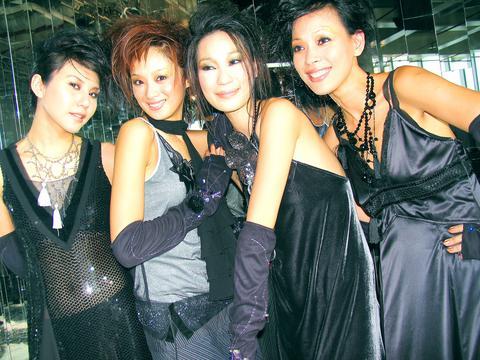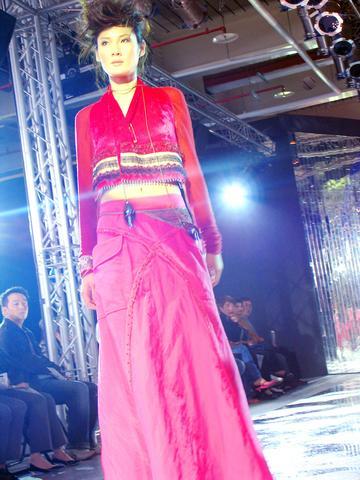The show had to go on despite an angry Typhoon Aere. Models queued up for their turn on the catwalk to breezily parade the Autumn/Winter collection of one of the country's top designers, Fu Zi-jing (
The event, held Tuesday at a sandbagged building in central Taipei, was a kind of coming-out party for a designer who has been a leading light on the local fashion scene for over a decade. Dresses in cherry red, bright pinks and blues loudly announced that Fu was taking a departure from her more usual black and neutral tones, for what she called a "romantic" look.

PHOTO: JULES QUARTLY, TAIPEI TIMES
Her signature black gowns were elegantly put together with the usual painstaking eye for detail, as shown by the embroidered hems, cut lines, folds, accessories and wide-range of fabrics, many of them from original designs.

PHOTO: JULES QUARTLY, TAIPEI TIMES
But it was the red outfit, with the long-sleeved top and Tibetan-ethnic highlights, a bare-midriff and long skirt, that grabbed the attention. A pale indigo, robe-cum-cardigan worn over calf-length trousers was in a similar vein. If this relative explosion of color is a new direction, it would seem from the reaction of those there that it was going the right way.
"She hasn't really used red before, her style has changed a lot," said public relations director Ginny Chang (
"Though she has become famous, this became a bit of a headache for her. She was not happy with her collection. She tried to relax in her personal life and work. This effected her design, which has become more soft and mature.
Fu said her collection was inspired by the idea of opening a treasure box and said each design was the result of an idea or concept derived from an opera, a painting, a movie theme, an experience or a book.
Fashion photographer Mai Xian-yun (
"You can't compare Fu with other designers. In the beginning she [incorporated] foreign cultures and designers. She's now moved on from this. Everyone wants an international market, but its difficult to do this. Fu Zi-jing is one of the few designers to have the opportunities."
"Taiwan fashion is quite different from the rest of the world," Mai said, adding the leading players had all been successful abroad. He mentioned Sophie Hong (
"That's the concern about the next generation, many of them don't know the next step to make it international. They have a Taiwan market, but they need international looks."
Rather than just catering to niche markets locally, Mai said, the aim should be to develop a broader appeal in order to break into Europe, Japan and the US. "China is, of course, a massive opportunity for us."
Mai also said there was a need to co-opt the media and government so they could build a platform for designers to be noticed. But the recent Ministry of Economic Affairs-led initiative to give the fashion industry a lift, with the ambitious "Fuse 2004" program, has been a disappointment.
A planned month-long fashion party this month showcasing young talent was promoted as "linking Taiwan fashion design talents globally." It turned out to be a washout, with just one cat-walk show and an exhibition taking place.
A typhoon could not stop Fu Zi-jing. Perhaps there are lessons to be learned here.

This is the year that the demographic crisis will begin to impact people’s lives. This will create pressures on treatment and hiring of foreigners. Regardless of whatever technological breakthroughs happen, the real value will come from digesting and productively applying existing technologies in new and creative ways. INTRODUCING BASIC SERVICES BREAKDOWNS At some point soon, we will begin to witness a breakdown in basic services. Initially, it will be limited and sporadic, but the frequency and newsworthiness of the incidents will only continue to accelerate dramatically in the coming years. Here in central Taiwan, many basic services are severely understaffed, and

Jan. 5 to Jan. 11 Of the more than 3,000km of sugar railway that once criss-crossed central and southern Taiwan, just 16.1km remain in operation today. By the time Dafydd Fell began photographing the network in earnest in 1994, it was already well past its heyday. The system had been significantly cut back, leaving behind abandoned stations, rusting rolling stock and crumbling facilities. This reduction continued during the five years of his documentation, adding urgency to his task. As passenger services had already ceased by then, Fell had to wait for the sugarcane harvest season each year, which typically ran from

It is a soulful folk song, filled with feeling and history: A love-stricken young man tells God about his hopes and dreams of happiness. Generations of Uighurs, the Turkic ethnic minority in China’s Xinjiang region, have played it at parties and weddings. But today, if they download it, play it or share it online, they risk ending up in prison. Besh pede, a popular Uighur folk ballad, is among dozens of Uighur-language songs that have been deemed “problematic” by Xinjiang authorities, according to a recording of a meeting held by police and other local officials in the historic city of Kashgar in

The People’s Republic of China (PRC) was out in force in the Taiwan Strait this week, threatening Taiwan with live-fire exercises, aircraft incursions and tedious claims to ownership. The reaction to the PRC’s blockade and decapitation strike exercises offer numerous lessons, if only we are willing to be taught. Reading the commentary on PRC behavior is like reading Bible interpretation across a range of Christian denominations: the text is recast to mean what the interpreter wants it to mean. Many PRC believers contended that the drills, obviously scheduled in advance, were aimed at the recent arms offer to Taiwan by the